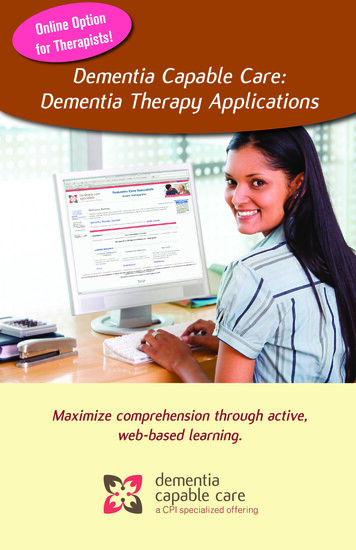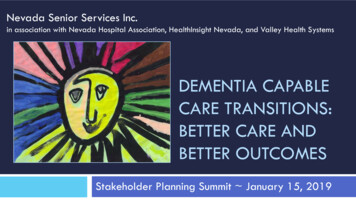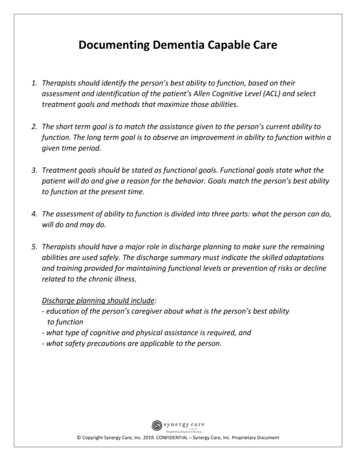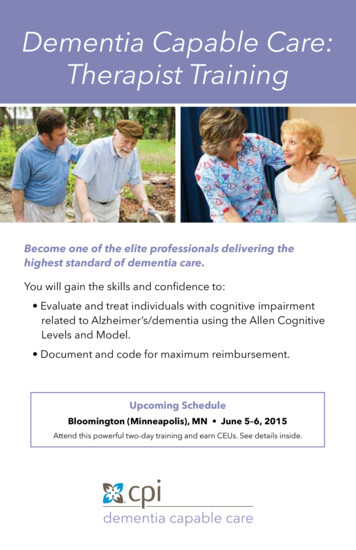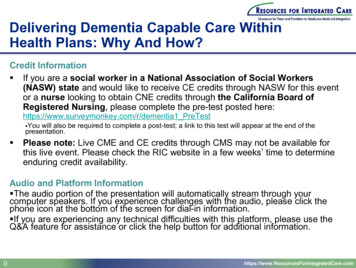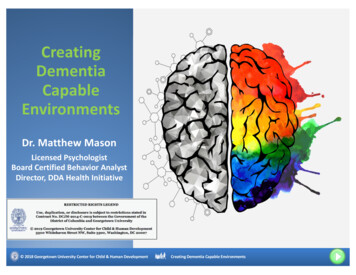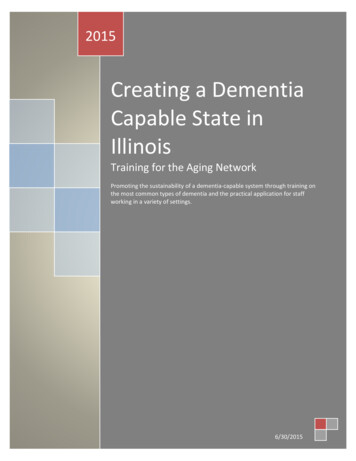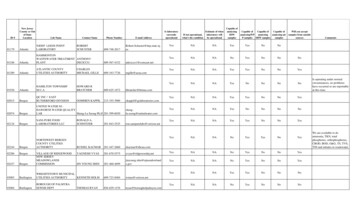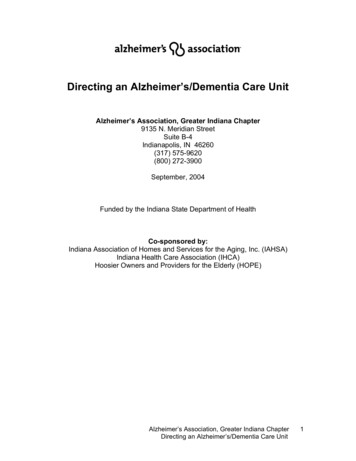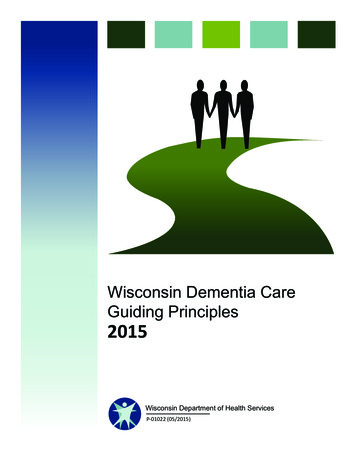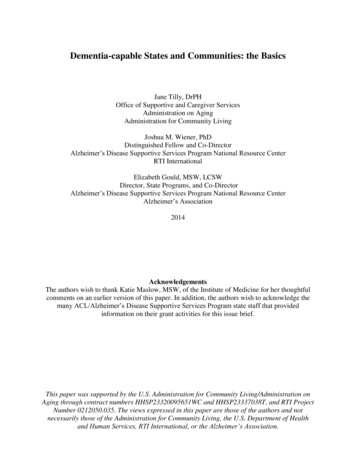
Transcription
Dementia-capable States and Communities: the BasicsJane Tilly, DrPHOffice of Supportive and Caregiver ServicesAdministration on AgingAdministration for Community LivingJoshua M. Wiener, PhDDistinguished Fellow and Co-DirectorAlzheimer’s Disease Supportive Services Program National Resource CenterRTI InternationalElizabeth Gould, MSW, LCSWDirector, State Programs, and Co-DirectorAlzheimer’s Disease Supportive Services Program National Resource CenterAlzheimer’s Association2014AcknowledgementsThe authors wish to thank Katie Maslow, MSW, of the Institute of Medicine for her thoughtfulcomments on an earlier version of this paper. In addition, the authors wish to acknowledge themany ACL/Alzheimer’s Disease Supportive Services Program state staff that providedinformation on their grant activities for this issue brief.This paper was supported by the U.S. Administration for Community Living/Administration onAging through contract numbers HHSP23320095651WC and HHSP23337038T, and RTI ProjectNumber 0212050.035. The views expressed in this paper are those of the authors and notnecessarily those of the Administration for Community Living, the U.S. Department of Healthand Human Services, RTI International, or the Alzheimer’s Association.
Dementia-capable States and Communities: the BasicsIntroductionDementia, including Alzheimer’s disease, touches almost everyone’s life. People may havedementia or know or care for someone who has it. Others may fear getting it as they age. Manyof us interact with people who have dementia or their families as we provide services, or meetthem socially. We may not even know that a person has it.If a person has some type of dementia, the person has a loss of brain function that leads toproblems in at least two areas that are severe enough to affect daily life. For example, a personmay have memory and language problems.People with dementia experience losses over time, which may involve cognitive problems likedifficulty with learning, thinking, and remembering. People also can have physical symptomssuch as difficulty walking, talking, and eating. Some dementias involve troubling behaviorchanges. All of these problems interfere with their normal activities and relationships andgenerally get worse over time. The result is dependence on others.Certain brain diseases and conditions cause dementia. Alzheimer’s disease, which is progressiveand fatal, is the most common form of dementia. Alzheimer’s is only one type of dementia. Afew causes of dementia are reversible, such as normal pressure hydrocephalus and cerebralvasculitis.1 Symptoms of other conditions, such as depression, delirium, alcohol misuse, andbrain tumors, can resemble dementia. So can the effects of certain drugs and medicineinteractions.As dementia progresses, people depend more on others for help with activities ranging frommanaging finances to the most personal tasks such as eating and bathing. At some point, peoplecannot manage their lives on their own. Caregivers, who are family or friends, generally helpwithout pay out of a feeling of love or duty. Eventually, the demands of caring for someone withdementia may become more than caregivers can manage without help. Then, people withdementia and their families rely on paid caregivers in the home and community, or in institutionslike nursing homes.The Secretary of Health and Human Services (HHS) leads the National Plan to AddressAlzheimer’s Disease, which deals with many of these issues. The Plan provides a nationalstrategy for strengthening research, medical care, and long-term services and supports for thoseliving with dementia, including Alzheimer’s disease. It contains actions for federal agencies,states, and communities related to dealing with the unique needs of people with dementia, andtheir families. The Plan, which the 2011 National Alzheimer’s Project Act requires, has 5 goals:1. Prevent and effectively treat Alzheimer’s disease by 2025.2. Optimize care quality and efficiency.3. Expand supports for people with Alzheimer’s disease and their families.4. Enhance public awareness and engagement.5. Track progress and drive improvement.1
Using these goals as guidance, we discuss how states and communities can become dementiacapable, that is, able to help people with dementia and their caregivers. To show how this can bedone, we provide examples from the United States and some other countries. We begin byexplaining why dementia-capability is so important for families, their communities, states, andthe nation.The Impact of DementiaIndividuals, their families, communities, and states face a number of challenges in dealing withdementia. These include the impact of the diseases that cause dementia on individuals andfamilies, the number of people with the condition, and the cost of care.While dementia results from the loss of brain cells and the connections among cells, symptomscan vary by type of dementia. For example, in frontotemporal disorders, dementia symptoms caninclude changes in personality, behavior, language, and movement. Symptoms in the early stagesof Alzheimer’s disease include a declining memory and difficulty managing finances and healthcare. People with Alzheimer’s may also have behavioral symptoms,2 such as agitation anddepression. Wandering away from home is a common and serious safety issue. As dementiaprogresses, people typically need help with bathing, dressing, eating, and other basic dailyactivities. In the final stages of dementia, people can barely communicate, fail to recognizefamily members, and need constant care. Given these losses, it is surprising that among people71 years and older, 17 percent of people with severe dementia and 25 percent of people withmoderate dementia live alone.3In addition to relying more on family, people with dementia can lose their savings when theylose their jobs or need to pay for additional services. Another risk is that people with dementiaare vulnerable to elder abuse, including financial exploitation. As a result, many people end uprelying on Medicaid and other public programs to help finance their services and supports.As dementia progresses, caregivers can experience more stress as they provide more services andsupports, such as supervision and personal care.4 Caring for people with dementia is particularlydifficult because of the way it affects abilities and behavior. Caregivers of people with dementiaare more likely than caregivers of other older people to help with all daily activities, includinggetting out of bed, using the toilet and eating. 5 The resulting strain causes many caregivers tohave high levels of stress, become depressed, and have financial worries. These worries maycome from time lost at work or even job loss as caregiving time increases.6 7Estimates of the number of people with dementia vary, but studies suggest that as many as 5million Americans 65 years and older and about 200,000 individuals under age 65 may have thedisease.8 Since age is a major risk factor for dementia, researchers expect that the number ofpeople with the condition will grow as the U.S. population ages. States that use the cognitiveimpairment module of the Behavioral Risk Factor Surveillance System (BRFSS) from theCenters for Disease Control and Prevention can develop their own estimates of the number ofpeople with cognitive disabilities. Information about the BRFSS can be found nce.htm.Estimates of the number of caregivers for people with dementia vary. An analysis of the 2011National Health and Aging Trends Survey of Medicare beneficiaries 65 years and older showsthat 5.8 million caregivers are helping people who probably have dementia.9 The number ofcaregivers of people with dementia is also likely to grow with the aging of the population.2
Use of Medical and Long-term Services and SupportsDementia complicates managing medical care. Those with the condition often have other chronicdiseases, such as heart disease, diabetes, and arthritis10 and are more likely to have themcompared to those without dementia.11 Cognitive problems can lead to poor management ofother diseases and increased risk of falls.12 13 For example, on average, people with dementiahave three times as many hospital stays and three times the average Medicare expenditure ofother older people.14 Recent studies of coordinated care designed to help people with cognitivedisability and their caregivers move from medical settings to home appear to better meet theirneeds than usual care.15Many people who need long-term services and supports (LTSS) have cognitive problems, whichoften come from dementia. Fifteen percent of older adults living in the community with at leastone limitation in a daily activity have a cognitive disability and the percentage increases withseverity of disability.16 As a result, people with dementia form a large percentage of people usingLTSS. Over 40 percent of nursing home residents have a diagnosis of dementia; most often theyhave Alzheimer’s disease.17 The percentage is higher among nursing home residents who areeligible for both Medicare and Medicaid. Not surprisingly, people with cognitive disabilities arehigh users of home and community services. Approximately 24 percent of people of all ages whoreceive Medicare or Medicaid-funded home health care have moderate to severe cognitivedisability.18 Similarly, more than a quarter of Medicare-Medicaid dual eligibles who receivehome and community-based services through Medicaid waiver programs have Alzheimer’sdisease or other types of dementia.19The large number of people with dementia makes it a costly condition for individuals, families,and the nation. Researchers estimate that dementia care for people 70 years and older in the U.S.cost between 159 billion and 215 billion in 2010, depending on how informal care costs arecalculated.20 Costs stem from supports and services, and from loss of paid employment forcaregivers, among other causes. Costs would be even higher if people under age 70 wereincluded in these estimates.State and Community Dementia-CapabilityStates and communities have many people at risk of or living with dementia. They live alone orwith family and they use all service systems, public and private. People with dementia rely ontheir families and faith communities, grocery stores and banks, and medical, health, and LTSS,among other services. The long, slow progress of most dementias means that the needs of peoplewith the condition and their caregivers change and become more intense over time.Below we describe a model dementia-capable system. Given the impact of the condition onpeople and communities, service systems that wish to be dementia-capable should consideradopting key aspects of the model that apply to their mission. We developed this model based ontwo sets of information: research on dementia progression and supportive services, and anevaluation of Administration for Community Living (ACL) grantee experience in developingdementia-capable systems.A model system would:1. Educate the public about brain health. This would include information about the riskfactors associated with developing dementia, first signs of cognitive problems,3
management of symptoms if individuals have dementia, support programs, andopportunities to participate in research.2. Identify people with possible dementia and recommend that they see a physician for atimely, accurate diagnosis and to rule out reversible causes of dementia or conditions thatresemble it.3. Ensure that program eligibility and resource allocation take into account the impact ofcognitive disabilities.4. Ensure that staff communicate effectively with people with dementia and their caregiversand provide services that:a) Are person- and family-centeredb) Offer self-direction of servicesc) Are culturally appropriate5. Educate workers to identify possible dementia, and understand the symptoms of dementiaand appropriate services.6. Implement quality assurance systems that measure how effectively providers servepeople with dementia and their caregivers.7. Encourage development of dementia-friendly communities, which include key parts ofdementia-capability.Below we elaborate on how organizations might develop those aspects of a model system thatapply to their mission, work, and communities. These aspects are for discussion purposes andcould be adapted to an organization or community’s individual situation.1. Educate the publicStates and communities have a role in educating the public about health. There are four generalcategories related to education about brain health and dementia, with free federal resourcesavailable:a) One way to discuss the possible risk factors associated with dementia with the public is inrelation to brain health. Although we do not know how to prevent Alzheimer’s disease,experts say that some actions that can help us maintain cognitive abilities, such asavoiding head injury, not smoking, and getting enough sleep. Physical exercise,managing chronic diseases like diabetes and hypertension, and social and mentalengagement also can promote brain health and have been linked to lower risk ofAlzheimer’s. HHS’ Brain Health Resource provides current, evidence-based informationand resources that can help states and communities educate people about brain health.The Resource, which is available athttp://www.acl.gov/Get Help/BrainHealth/Index.aspx, contains a consumer fact sheet,presentation slides, educator guide, and list of resources that people can use.b) People need to know about signs of cognitive problems and how to follow up if there isconcern. If someone receives a dementia diagnosis, the person and caregivers needinformation about how to manage its difficult symptoms. Free consumer-friendlyinformation about how to cope with symptoms can be found in two places:4
i. Alzheimer’s Disease Education and Referral (ADEAR) Center website:http://www.nia.nih.gov/alzheimers. The National Institute on Aging at theNational Institutes of Health (NIH) sponsors this site, which offers current,research-based information and publications for families, caregivers, andprofessionals on diagnosis, treatment, patient care, caregiver needs, long-termcare, education and training, and research related to Alzheimer’s disease and agerelated cognitive change.ii. The National Alzheimer’s Call Center, which offers advice 24 hours/7 days aweek to people who have questions and need advice about dementia. The phonenumber is 1.800.272.3900. ACL helps support the Alzheimer’s Association’soperation of this service.c) Staff can find out about evidence-based programs that serve people with dementia andtheir caregivers by consulting a white paper – Translating Innovation to Impact:Evidence-based interventions to support people with Alzheimer’s disease and theirCaregivers at home and in their Communities. This paper and its related webinar describesuccessful interventions that help people in the early stages of dementia, familycaregivers, and those who coordinate health and long-term services and supports forthem. These resources are available at:http://aoa.gov/AoARoot/AoA Programs/HPW/Alz Grants/index.aspx.d) The public needs to know about opportunities to participate in research. A great deal hasbeen learned about dementia in recent years, and scientists continue to seek volunteers,both with and without dementia, to help test promising interventions, from medications tolifestyle and behaviors. The National Institute on Aging at NIH sponsors the Alzheimer’sDisease Research and Education Centers and the Alzheimer’s Disease Cooperative Study,which conduct a number of studies. Connections to these research centers and otheropportunities to participate in research are available s. Another resource is the Alzheimer'sAssociation TrialMatch located at www.alz.org/trialmatch. Both websites listopportunities that come from a wide variety of research facilities and trial sites across theU.S.2. Identify people with possible dementiaProviding appropriate care to people with dementia and their caregivers will not happen unlessservice providers can identify people with the condition. Individuals or caregivers may contactservice providers to discuss memory problems, trouble managing finances or medical care orbehavior changes. Service provider staff can learn to recognize whether a person may bedescribing signs of cognitive problems and refer the individual for an accurate diagnosis.Aging and Disability Resource Centers and Area Agencies on Aging (AAAs), which are thelocal agencies that people with disabilities often contact for public services, use five generalstrategies for identifying people with dementia and their caregivers.a) Agencies (such as MinnesotaHelp.Info) add dementia-specific questions to theirinformation gathering and assessment forms.21 In Missouri, AAA staff use the AD8assessment to screen for dementia and to refer people who appear to have problems to theAlzheimer’s Association.22 In Washington State, AAAs use the TCARE tool in theirFamily Caregiver Support Program to provide reliable screening and assessment, identify5
high-risk caregivers, ensure that available resources go to those most in need, and todetermine whether services make a measurable difference to caregivers.23b) Staff at local agencies receives training to recognize possible cognitive impairment intheir conversations with callers and in other interactions and about how various ethnicgroups regard dementia.24c) Agencies, such as AAAs, create processes for referral of people with possible cognitiveimpairment for professional assessment.d) Agencies partner with organizations specializing in dementia. For example, staff of thelocal chapter of the Alzheimer’s Association spend one day per month at the Aging andDisability Resource Center in Racine, Wisconsin, providing training for its staff andinformation and referral for callers and walk-in clients.25e) Practitioners who see people concerned about cognitive problems need to understand thepossible signs of dementia, which can be found at the following . If necessary, practitioners must be able to assess a person’s cognition or referthem to a physician who can. There are many brief cognitive screening tools available toidentify cognitive problems. The NIA provides a searchable database of them ment. The Alzheimer’s Associationasked medical experts for their recommendations for screening tools for use in primarycare. These can be found /journals/15525260/PIIS1552526012025010.pdf . In addition, ACL sponsored an assessment ofcognitive screening tools that non-medical staff can use. This assessment can be found athttp://www.adrc-tae.acl.gov/tiki-download file.php?fileId 33535.If an assessment shows that a person has cognitive problems, it is important to find out the cause.A few causes of dementia are reversible and some other conditions can resemble it. In addition,while Alzheimer’s disease is responsible for 60 to 80 percent of dementia, there are otherdiseases that cause dementia, like Parkinson’s disease, Lewy body disease, and frontotemporaldementia. HHS offers a free educational program on this topic for practitioners available throughMedscape that provides continuing education units for those who complete it. This program iscalled Case Challenges in Early Alzheimer’s Disease, which is available after a free registrationat www.medscape.com.3. Ensure Appropriate Eligibility Criteria and Resource AllocationMost public programs offering home and community services have criteria for deciding whethera person can receive them. Those programs with eligibility criteria based on a person’s ability tocarry out daily activities need to
Dementia-capable States and Communities: the Basics Introduction Dementia, including Alzheimer’s disease, touches almost everyone’s life. People may have dementia or know or care for someone who has it. Others may fear getting it as they age. Many of us interact with people who have dementia or their families as we provide services, or meetFile Size: 356KB
